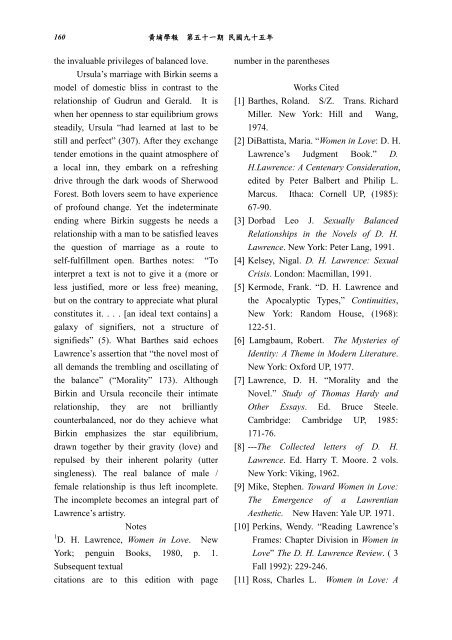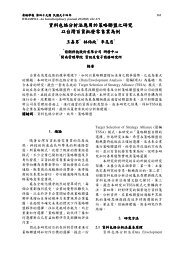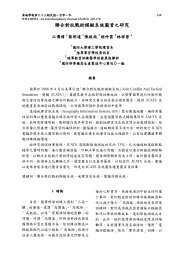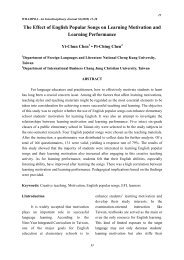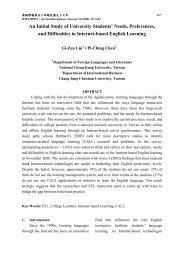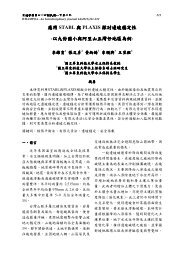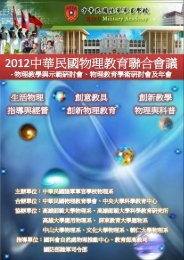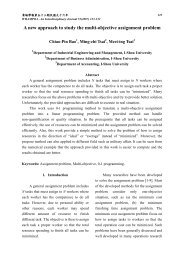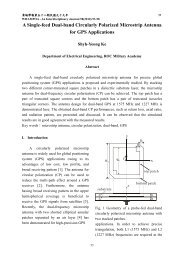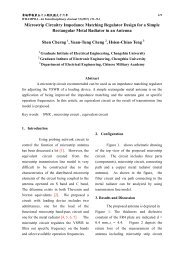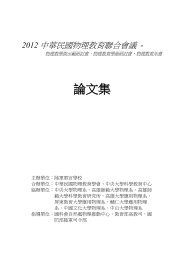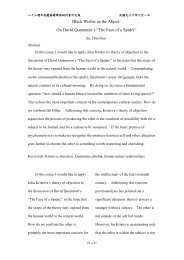Women in Love: the Male / Female Relationships
Women in Love: the Male / Female Relationships
Women in Love: the Male / Female Relationships
Create successful ePaper yourself
Turn your PDF publications into a flip-book with our unique Google optimized e-Paper software.
160 黃 埔 學 報 第 五 十 一 期 民 國 九 十 五 年<br />
<strong>the</strong> <strong>in</strong>valuable privileges of balanced love.<br />
Ursula’s marriage with Birk<strong>in</strong> seems a<br />
model of domestic bliss <strong>in</strong> contrast to <strong>the</strong><br />
relationship of Gudrun and Gerald. It is<br />
when her openness to star equilibrium grows<br />
steadily, Ursula “had learned at last to be<br />
still and perfect” (307). After <strong>the</strong>y exchange<br />
tender emotions <strong>in</strong> <strong>the</strong> qua<strong>in</strong>t atmosphere of<br />
a local <strong>in</strong>n, <strong>the</strong>y embark on a refresh<strong>in</strong>g<br />
drive through <strong>the</strong> dark woods of Sherwood<br />
Forest. Both lovers seem to have experience<br />
of profound change. Yet <strong>the</strong> <strong>in</strong>determ<strong>in</strong>ate<br />
end<strong>in</strong>g where Birk<strong>in</strong> suggests he needs a<br />
relationship with a man to be satisfied leaves<br />
<strong>the</strong> question of marriage as a route to<br />
self-fulfillment open. Bar<strong>the</strong>s notes: “To<br />
<strong>in</strong>terpret a text is not to give it a (more or<br />
less justified, more or less free) mean<strong>in</strong>g,<br />
but on <strong>the</strong> contrary to appreciate what plural<br />
constitutes it. . . . [an ideal text conta<strong>in</strong>s] a<br />
galaxy of signifiers, not a structure of<br />
signifieds” (5). What Bar<strong>the</strong>s said echoes<br />
Lawrence’s assertion that “<strong>the</strong> novel most of<br />
all demands <strong>the</strong> trembl<strong>in</strong>g and oscillat<strong>in</strong>g of<br />
<strong>the</strong> balance” (“Morality” 173). Although<br />
Birk<strong>in</strong> and Ursula reconcile <strong>the</strong>ir <strong>in</strong>timate<br />
relationship, <strong>the</strong>y are not brilliantly<br />
counterbalanced, nor do <strong>the</strong>y achieve what<br />
Birk<strong>in</strong> emphasizes <strong>the</strong> star equilibrium,<br />
drawn toge<strong>the</strong>r by <strong>the</strong>ir gravity (love) and<br />
repulsed by <strong>the</strong>ir <strong>in</strong>herent polarity (utter<br />
s<strong>in</strong>gleness). The real balance of male /<br />
female relationship is thus left <strong>in</strong>complete.<br />
The <strong>in</strong>complete becomes an <strong>in</strong>tegral part of<br />
Lawrence’s artistry.<br />
Notes<br />
1 D. H. Lawrence, <strong>Women</strong> <strong>in</strong> <strong>Love</strong>. New<br />
York; pengu<strong>in</strong> Books, 1980, p. 1.<br />
Subsequent textual<br />
citations are to this edition with page<br />
number <strong>in</strong> <strong>the</strong> paren<strong>the</strong>ses<br />
Works Cited<br />
[1] Bar<strong>the</strong>s, Roland. S/Z. Trans. Richard<br />
Miller. New York: Hill and Wang,<br />
1974.<br />
[2] DiBattista, Maria. “<strong>Women</strong> <strong>in</strong> <strong>Love</strong>: D. H.<br />
Lawrence’s Judgment Book.” D.<br />
H.Lawrence: A Centenary Consideration,<br />
edited by Peter Balbert and Philip L.<br />
Marcus. Ithaca: Cornell UP, (1985):<br />
67-90.<br />
[3] Dorbad Leo J. Sexually Balanced<br />
<strong>Relationships</strong> <strong>in</strong> <strong>the</strong> Novels of D. H.<br />
Lawrence. New York: Peter Lang, 1991.<br />
[4] Kelsey, Nigal. D. H. Lawrence: Sexual<br />
Crisis. London: Macmillan, 1991.<br />
[5] Kermode, Frank. “D. H. Lawrence and<br />
<strong>the</strong> Apocalyptic Types,” Cont<strong>in</strong>uities,<br />
New York: Random House, (1968):<br />
122-51.<br />
[6] Lamgbaum, Robert. The Mysteries of<br />
Identity: A Theme <strong>in</strong> Modern Literature.<br />
New York: Oxford UP, 1977.<br />
[7] Lawrence, D. H. “Morality and <strong>the</strong><br />
Novel.” Study of Thomas Hardy and<br />
O<strong>the</strong>r Essays. Ed. Bruce Steele.<br />
Cambridge: Cambridge UP, 1985:<br />
171-76.<br />
[8] ---The Collected letters of D. H.<br />
Lawrence. Ed. Harry T. Moore. 2 vols.<br />
New York: Vik<strong>in</strong>g, 1962.<br />
[9] Mike, Stephen. Toward <strong>Women</strong> <strong>in</strong> <strong>Love</strong>:<br />
The Emergence of a Lawrentian<br />
Aes<strong>the</strong>tic. New Haven: Yale UP. 1971.<br />
[10] Perk<strong>in</strong>s, Wendy. “Read<strong>in</strong>g Lawrence’s<br />
Frames: Chapter Division <strong>in</strong> <strong>Women</strong> <strong>in</strong><br />
<strong>Love</strong>” The D. H. Lawrence Review. ( 3<br />
Fall 1992): 229-246.<br />
[11] Ross, Charles L. <strong>Women</strong> <strong>in</strong> <strong>Love</strong>: A


